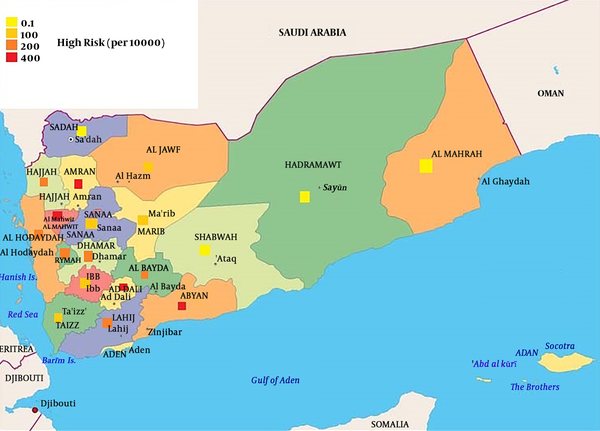Dear Editor,
Vibrio cholera is gram-negative, curved shape with polar flagella bacterium which lives in alkali condition of contaminated waters (with cholera faces) around the worldwide; Vibrio cholerae O1 (both of classic and El Tor biogroups) and O139 can cause of lethal acute diarrhea in small intestine of human using production of CtxA (cholera enterotoxin subunit A) which leads to lost water, electrolytes and hypovolemic shock (1, 2).
According to WHO (World Health Organization) reports, there are annually 3 to 5 million cases and 100 - 120 thousand death cause of cholera. Unfortunately, this status is worse among children, Lanata et al. estimated globally 11 million cholera cases among children lower than 5 years every year (2, 3). There are several outbreaks of cholera in developing countries such as Bangladesh (after floods), Zimbabwe and Haiti (followed by earthquake); Ali et al. estimated that approximately 1.4 billion people are at risk of cholera in endemic areas (2).
In recently years, Yemen cholera outbreak is began in October 2016 due to Vibrio cholerae O1 (serotype Ogawa) from Sana’a to 15 neighboring countries in December 2016; given that WHO reports, there are nearly 700,000 cases and more than 2000 deaths with 362,545 suspected patients caused by cholera in this outbreak; Moreover, The WHO has successfully established 47 cholera treatment facilities, cholera vaccination plan, training of 310 health workers, 788 000 bags of intravenous solutions, 112 cholera treatment kits and US$ 10.2 million dollars from controlling the Yemen-outbreak (3, 4). According to latest WHO reports from Yemen in November 2018.
There are total number 242,849 suspected cholera cases during 1 January 2018 to 21 October 2018 which have been estimated than 31.7% of this cases are children under five year-olds; Moreover, 2178 cases have been confirmed as cholera using standard conventional microbiogical assays from total of 8263 samples collected during 2018 (3).
Yemen is a war country by Saudi Arabia and Qaeda in the Arabian Peninsula; about 7800 people have been killed and 44 000 injured in this war; also, 14.5 million people are need of health assist, about 15 million people do not have access to suitable drinking water, 274 health center have been demolished and in this situation, Yemen’s Health-Care Organization is in a faint state (3-5). Cholera disease can have transmitted through fecal-oral and fecal contamination of drinking water resources with person-to-person pattern which this process is repeated in Yemen outbreak; the reports was showed that cholera outbreak is severed in Yemen followed by heavy rains which contaminated drinking water and exacerbated by war in April 2017 with rate of 5000 persons in day. According to Yemen Ministry of Public Health; more than 40% of all Yemen’s cholera cases are children and cholera is continuous with prevalence of higher than 65 percent (Figure 1) (3-6).
There are several major strategies for treatment of cholera including patient detection and appropriate treatment, treatment drinking water sources, elimination of sewage water, oral cholera vaccination and describing the intravenous fluids (3, 7). Despite all problems, the WHO and UNICEF have provided several medical supplies, health workers, health-care centers, oral cholera vaccine (OCV), diarrhoea treatment centers (DTCs), oral rehydration therapy corners (ORCs), cholera kits, cholera beds, antibiotics and several million dollars for prevention and controlling the Yemen-cholera outbreak (3). Based on the WHO reports, the epidemic cholera in Yemen is occurred in 2016; but the incidence rates of cholera is declined in early 2017, but the second terrible epidemic was started in April 2017 and in currently, cholera outbreak is continually spreading in this regions; although Nishiura et al. declared that the Yemen cholera epidemic is declined very soon (3, 6).
Given that literatures, cholera epidemic has self-limitation nature (8). But contrast with this phenomenon; There are several cholera outbreaks have been alternated in Yemen during several recent months (3). Therefore, it is seeming that is necessary to established serious epidemiological studies on V. cholera strains of Yemen outbreaks in order to serotyping, determine clonal expansions of this strains among Yemen several provinces patients or evaluation for genetically manipulation of V. Cholera strains in Yemen in order to better understanding about main cause of alternative occurrence of cholera outbreaks in Yemen.
In finally, the Yemen cholera epidemic can have continued and speeded through Saudi Arabia and Africa which cause of global pandemic cholera and several billion death in the worldwide; Therefore, financial supporting the WHO, stopping the bombing and war in Yemen, patient detection and treatment, drinking water sources treatment and sanitation are gold strategies for controlling the second wave of Yemen-cholera outbreak before it lead to global problem.
